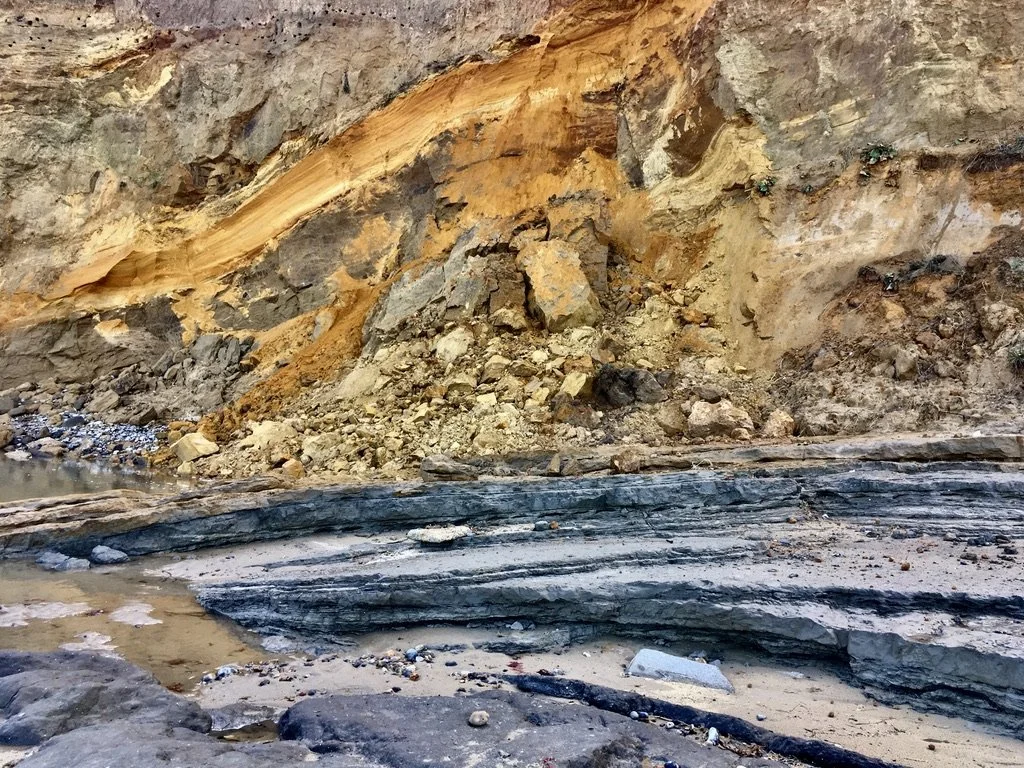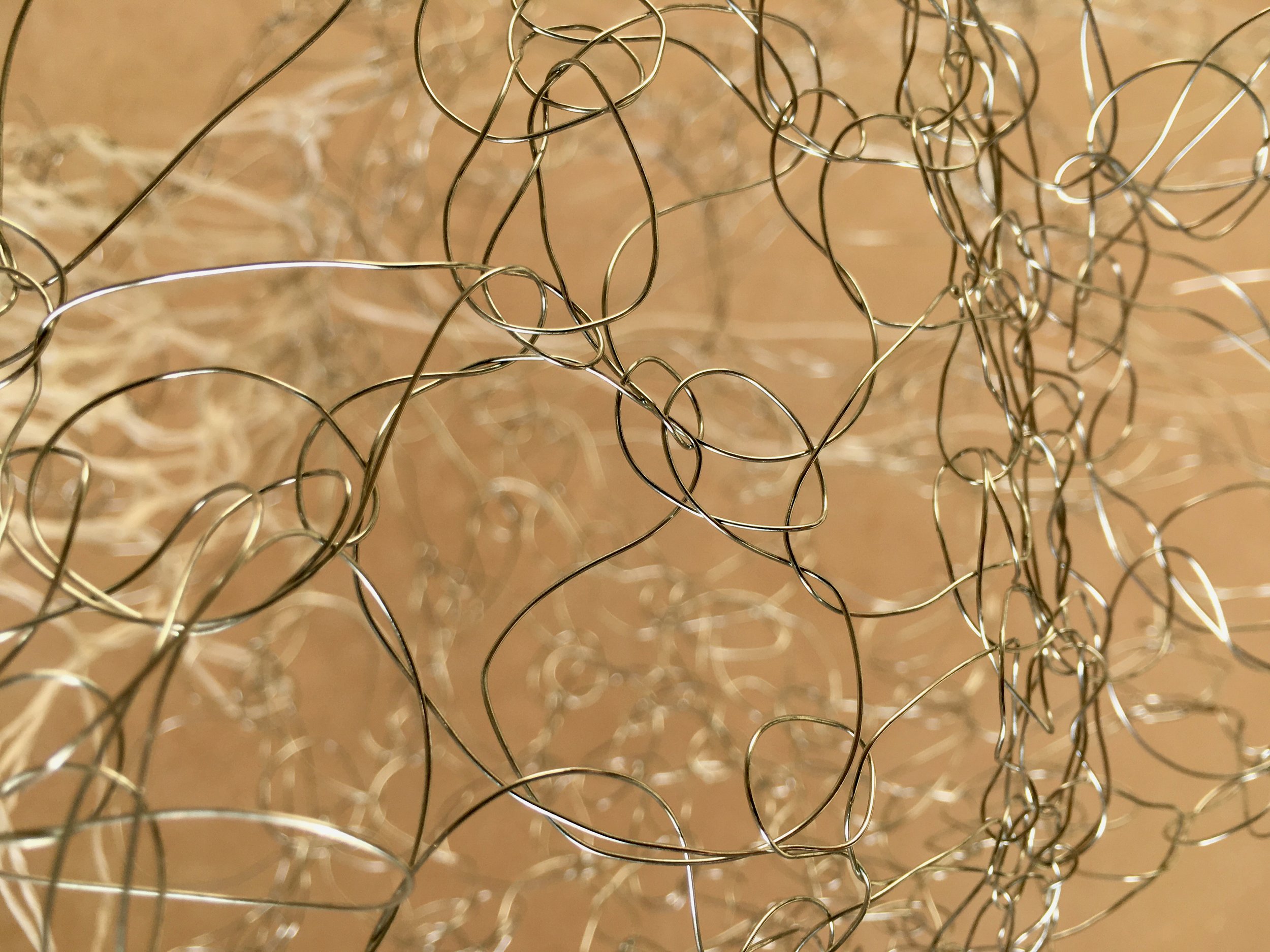Unfolding The Fold
Folds of material within the cliff face at Happisburgh, Norfolk (2020) – Lynda Beckett
Within The Fold (1993), Deleuze folds notions of matter, soul, and the Baroque through the thoughts of other philosophers and thinkers, within the fields of the arts, architecture, philosophy and mathematics. Deleuze folds fold upon fold. For Deleuze, folds are matter, and matter becomes material, and as abstract thoughts, material entangles with the sensual, through the works of Mallarmé, Hantaï and Klee.
A greater exploration of Deleuze’s method of creating ‘folds’ is necessary before I move from the fold to the knot and knotworks, and before grappling with Deleuze’s abstract concepts of ‘the pleats of matter’, material, and ‘the folds in the soul’. Deleuze’s method of thinking is an act of folding his own thoughts[1] and those of others, into his thinking and writing process. Simon O’Sullivan describes the process as ‘a folding – or doubling’ of his ‘thought into the thought of another’ (2005, p. 102)2. This is not where Deleuze’s folding method stops; he plays with the definitions of familiar words, such as ‘fold’ and ‘baroque’ while entangling notions of ‘the pleats of matter’ and ‘the folds in the soul’ into his concept. This notion of folding thought and material is relevant to my practice because it parallels my own process as I fold the physical materials and words to create new works.
Deleuze’s thinking unfolds notions of matter, flow and infinity through the Baroque and Leibniz[2]. Leibniz’s concept of ‘material continuum’ is central to Deleuze’s concept of the fold, as matter is always in motion between two folds. My focus is on the fluidity of matter as it materialises within my practice. Deleuze highlights the curvaceous forms, blurred edges, and exaggerated lighting of Baroque painters, who create intense emotion within their works. These intense emotions emit the sensual and this is an important notion within my inquiry. The felt, the unseen, through the folding of materials intrigues me. This notion of the sensual is influenced by a Deleuzian understanding of Baroque as that which ‘affects not only all kinds of materials, which thus become matter of expression in accordance with different scales and speeds and vectors (the mountains and the waters, papers, fabrics, living tissues, the brain) but it also determines and brings form into being and into appearance, it makes of it a form of expression…’ (1991, p. 242). Deleuzian folds can be material, physical and conceptual. As singularities, folds are encompassed within a greater fold, creating a new fluid form, such as knots within a knotwork. These knots are not confined to artworks. The concept of knots within knotworks is transversal. Folding Baroque back into Leibniz, Deleuze describes a concept as something that is formed from a gathering of singularities, as something that is worked upon and evolves into a different fluid form (Deleuze and Stivale, 1998, p. 78).
This practice of folding material, according to Andrew Benjamin, is workful (2005)[3], ‘an operative function’ (Deleuze, 1991, p. 227), one of productivity and creativity which goes beyond the confines of a classical period in history, as Deleuze demonstrates as he folds Plato, Proust, and Pollock into his form of Baroque (1993).
I RE-TURN II (2021) – Lynda Beckett
This method of folding to create resonates with my own practice. I RE-TURN II, 2021, is an example of reusing and refolding materials and thoughts to create the new through traditional craft methods. It is the physical act of folding one thread that forms the knot. At the intersect of more than two threads the beginnings of a knot is formed. Throughout the making process, my action is fluid, yet the structure of the form unknown, until the knotwork is complete. And in turn, the knotwork is more than a physical form. It envelops the singularities of Baroque and extends the concept of The Fold (Deleuze, 1993) to the knot. A fold is an intensifier of material. A knot is an intensifier of an intensifier as it is made of, through and by the fold, which in turn materialises as something else.
Knots, folds and voids within To Turn/ To Wind/ To Loop (2021) – Lynda Beckett
An aspect of the knot that gives the sculpture form is the void. The spaces between the knots, to me, create the sensual. I investigate this notion later in my inquiry. According to Deleuze, there are six ‘traits’ of the Baroque that form The Fold. These traits provide a framework for my practice. They include the fold, inside/outside, interior/exterior, high/low, texture and paradigm.
To Turn/ To Wind/ To Loop (2021) – Lynda Beckett
The fold
A thread is folded to form a slip knot at the beginning of each of my sculptural works. For me, this act of folding is a portal to another world. To Turn/ To Wind/ To Loop (2021b) is a crocheted wire and paper piece that evolved during the lockdown. In isolation, I sat in my room. Absorbed within the looping rhythm, my mind wandered as one knot followed another, as the monotony of motion paralleled that of time. Distracted, for a moment, I watched a funeral hearse drift by. The threads of wire and white paper turned from the living into the dead. The materials fold once again as the microbial becomes the living, and the cycle repeats within the folds of life.
The physical act of material folding is relevant to my inquiry as the process of folding enables me to think fluidly, without boundaries with regard to the living and the dead.
[1] See Deleuze (1988, p. 118) on ‘to think is to fold’.
[2] According to Deleuze, Gottfried Leibniz was ‘the first great German philosopher’ (Deleuze and Stivale, 1998, p. 77)
[3] A lecture given by Andrew Benjamin – The Appearance of Modern Architecture: Deleuze on the Baroque (2004).



